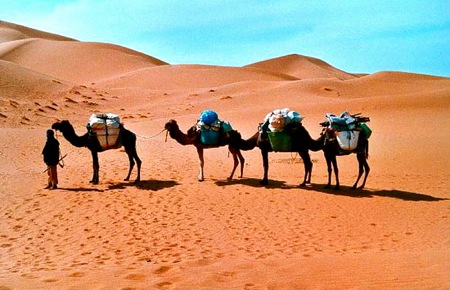Posts Tagged ‘Berbers Sahara Desert’
How does the Ramadan fast affect tourists traveling to the Imperial Cities, the Sahara Desert and other regions of Morocco during this high holy holiday? Can tourists eat or drink in public during Ramadan? This article should clear up the confusion on this issue for tourists, to explain the most polite solutions for tourist behavior at this time, and to assure tourists that there is no problem with them visiting Morocco during Ramadan. Because the Islamic calendar is lunar, holidays such as Ramadan advance by approximately ten days with each subsequent year. This means that Ramadan makes a cycle through the entire calendar of twelve months each twenty-some years. This year, Ramadan started on August 12th, 2010 in Morocco. The fast presently starts in Morocco at approximately 4:30 AM, and ends in the evening at approximately 7:30 PM.
For anyone interested in touring Morocco’s kasbahs or ksars, I highly recommend starting with Kasbah Taourirt, the Pasha Glaoui’s former palace in Ouarzazate. Kasbah Taorirt was built by the Pasha Glaoui. Its location was strategic for trading routes and in the 1930’s when the Glaoui ruled the South was then considered one of Morocco’s largest Kasbahs. Kasbah Taourirt was one of the places Glaoui kept his slaves. As a Moroccan traveler you can explore its nooks and crannies to discover its history and often local female painters who sell their art inside as well as the many quality silver shops just steps outside the Kasbah.

The Erg Chegaga Dunes of Morocco are the perfect place for a Sahara Adventure allowing Moroccan Travelers to escape the city lights and find themselves literally in the middle of no where. Erg Chegaga is considered by many to be the “real” Sahara Desert with it’s authentic rustic colored sand dunes and unique flora and fauna. Until recently cell phone coverage was not available in Chigaga and a Sahara journey to the Erg Chegaga Dunes was intended for those who wanted to discover the rocky and desolate areas of the Sahara. Historically speaking, the French and the British were primarily interested in visiting Chegaga however in the past several years that has changed. Americans, Europeans, Asians, Africans and also Moroccans who are interested in an authentic Sahara Desert adventure that takes them deep into the vast Sahara frequent Morocco’s Erg Chigaga Dunes. Centuries ago, the Sahara Desert was covered with water that flowed through and over it. Morocco’s Sahara akin to its rocky piste region of the Onila Valley and Telouet were created by the geologic submergence of water and wind that pressed up against its basalt rock and has today created some of what make up the most magnificent landscape scenery in the Maghreb.




